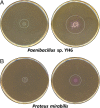Bacterial-induced pH shifts link individual cell physiology to macroscale collective behavior
- PMID: 33795512
- PMCID: PMC8040824
- DOI: 10.1073/pnas.2014346118
Bacterial-induced pH shifts link individual cell physiology to macroscale collective behavior
Abstract
Bacteria have evolved a diverse array of signaling pathways that enable them to quickly respond to environmental changes. Understanding how these pathways reflect environmental conditions and produce an orchestrated response is an ongoing challenge. Herein, we present a role for collective modifications of environmental pH carried out by microbial colonies living on a surface. We show that by collectively adjusting the local pH value, Paenibacillus spp., specifically, regulate their swarming motility. Moreover, we show that such pH-dependent regulation can converge with the carbon repression pathway to down-regulate flagellin expression and inhibit swarming in the presence of glucose. Interestingly, our results demonstrate that the observed glucose-dependent swarming repression is not mediated by the glucose molecule per se, as commonly thought to occur in carbon repression pathways, but rather is governed by a decrease in pH due to glucose metabolism. In fact, modification of the environmental pH by neighboring bacterial species could override this glucose-dependent repression and induce swarming of Paenibacillus spp. away from a glucose-rich area. Our results suggest that bacteria can use local pH modulations to reflect nutrient availability and link individual bacterial physiology to macroscale collective behavior.
Keywords: Paenibacillus spp.; carbon catabolite repression; pH modulation; swarming.
Conflict of interest statement
The authors declare no competing interest.
Figures






Similar articles
-
Anaerobic respiration using a complete oxidative TCA cycle drives multicellular swarming in Proteus mirabilis.mBio. 2012 Oct 30;3(6):e00365-12. doi: 10.1128/mBio.00365-12. mBio. 2012. PMID: 23111869 Free PMC article.
-
Surface-motility induction, attraction and hitchhiking between bacterial species promote dispersal on solid surfaces.ISME J. 2014 May;8(5):1147-51. doi: 10.1038/ismej.2013.218. Epub 2013 Dec 5. ISME J. 2014. PMID: 24304675 Free PMC article.
-
Tumble Suppression Is a Conserved Feature of Swarming Motility.mBio. 2020 Jun 16;11(3):e01189-20. doi: 10.1128/mBio.01189-20. mBio. 2020. PMID: 32546625 Free PMC article.
-
Shelter in a Swarm.J Mol Biol. 2015 Nov 20;427(23):3683-94. doi: 10.1016/j.jmb.2015.07.025. Epub 2015 Aug 12. J Mol Biol. 2015. PMID: 26277623 Free PMC article. Review.
-
[Characterization of bacterial swarming motility: a review].Sheng Wu Gong Cheng Xue Bao. 2023 Aug 25;39(8):3188-3203. doi: 10.13345/j.cjb.220892. Sheng Wu Gong Cheng Xue Bao. 2023. PMID: 37622355 Review. Chinese.
Cited by
-
Extended Plant Metarhizobiome: Understanding Volatile Organic Compound Signaling in Plant-Microbe Metapopulation Networks.mSystems. 2021 Aug 31;6(4):e0084921. doi: 10.1128/mSystems.00849-21. Epub 2021 Aug 24. mSystems. 2021. PMID: 34427518 Free PMC article.
-
pH Sensing Properties of Co3O4-RuO2-Based Electrodes and Their Application in Baltic Sea Water Quality Monitoring.Sensors (Basel). 2025 Feb 11;25(4):1065. doi: 10.3390/s25041065. Sensors (Basel). 2025. PMID: 40006295 Free PMC article.
-
Hydration conditions as a critical factor in antibiotic-mediated bacterial competition outcomes.Appl Environ Microbiol. 2025 Jan 31;91(1):e0200424. doi: 10.1128/aem.02004-24. Epub 2024 Dec 23. Appl Environ Microbiol. 2025. PMID: 39714150 Free PMC article.
-
Two-tiered mutualism improves survival and competitiveness of cross-feeding soil bacteria.ISME J. 2023 Nov;17(11):2090-2102. doi: 10.1038/s41396-023-01519-5. Epub 2023 Sep 22. ISME J. 2023. PMID: 37737252 Free PMC article.
-
Microfluidic approaches in microbial ecology.Lab Chip. 2024 Feb 27;24(5):1394-1418. doi: 10.1039/d3lc00784g. Lab Chip. 2024. PMID: 38344937 Free PMC article. Review.
References
-
- Jacob F., Monod J., Genetic regulatory mechanisms in the synthesis of proteins. J. Mol. Biol. 3, 318–356 (1961). - PubMed
-
- Lai H. C., et al. ., Effect of glucose concentration on swimming motility in enterobacteria. Biochem. Biophys. Res. Commun. 231, 692–695 (1997). - PubMed
-
- Moreno M. S., Schneider B. L., Maile R. R., Weyler W., Saier M. H. Jr, Catabolite repression mediated by the CcpA protein in Bacillus subtilis: Novel modes of regulation revealed by whole-genome analyses. Mol. Microbiol. 39, 1366–1381 (2001). - PubMed
Publication types
MeSH terms
Substances
Supplementary concepts
LinkOut - more resources
Full Text Sources
Other Literature Sources
Miscellaneous

